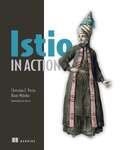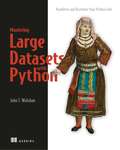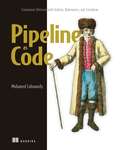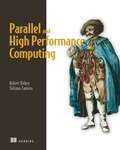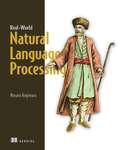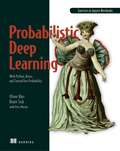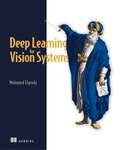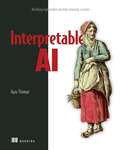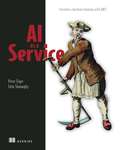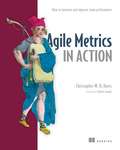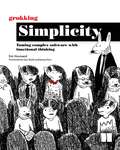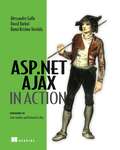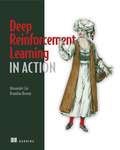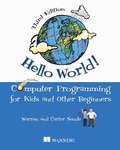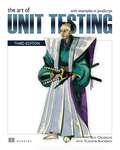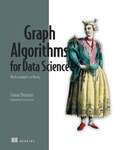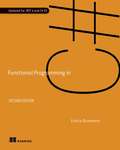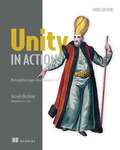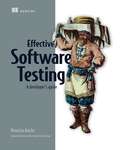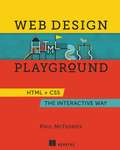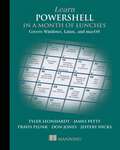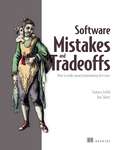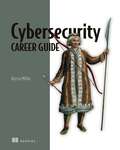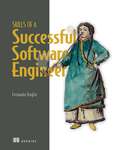- Table View
- List View
Istio in Action
by Christian E. Posta Rinor MalokuSolve difficult service-to-service communication challenges around security, observability, routing, and resilience with an Istio-based service mesh. Istio allows you to define these traffic policies as configuration and enforce them consistently without needing any service-code changes. In Istio in Action you will learn: Why and when to use a service mesh Envoy's role in Istio's service mesh Allowing "North-South" traffic into a mesh Fine-grained traffic routing Make your services robust to network failures Gain observability over your system with telemetry "golden signals" How Istio makes your services secure by default Integrate cloud-native applications with legacy workloads such as in VMs Reduce the operational complexity of your microservices with an Istio-powered service mesh! Istio in Action shows you how to implement this powerful new architecture and move your application-networking concerns to a dedicated infrastructure layer. Non-functional concerns stay separate from your application, so your code is easier to understand, maintain, and adapt regardless of programming language. In this practical guide, you'll go hands-on with the full-featured Istio service mesh to manage microservices communication. Helpful diagrams, example configuration, and examples make it easy to understand how to control routing, secure container applications, and monitor network traffic. About the technology Offload complex microservice communication layer challenges to Istio! The industry-standard Istio service mesh radically simplifies security, routing, observability, and other service-to-service communication challenges. With Istio, you use a straightforward declarative configuration style to establish application-level network policies. By separating communication from business logic, your services are easier to write, maintain, and modify. About the book Istio in Action teaches you how to implement an Istio-based service mesh that can handle complex routing scenarios, traffic encryption, authorization, and other common network-related tasks. You'll start by defining a basic service mesh and exploring the data plane with Istio&’s service proxy, Envoy. Then, you'll dive into core topics like traffic routing and visualization and service-to-service authentication, as you expand your service mesh to workloads on multiple clusters and legacy VMs. What's inside Comprehensive coverage of Istio resources Practical examples to showcase service mesh capabilities Implementation of multi-cluster service meshes How to extend Istio with WebAssembly Traffic routing and observability VM integration into the mesh About the reader For developers, architects, and operations engineers. About the author Christian Posta is a well-known architect, speaker, and contributor. Rinor Maloku is an engineer at Solo.io working on application networking solutions. ToC PART 1 UNDERSTANDING ISTIO 1 Introducing the Istio service mesh 2 First steps with Istio 3 Istio's data plane: The Envoy proxy PART 2 SECURING, OBSERVING, AND CONTROLLING YOUR SERVICE&’S NETWORK TRAFFIC 4 Istio gateways: Getting traffic into a cluster 5 Traffic control: Fine-grained traffic routing 6 Resilience: Solving application networking challenges 7 Observability: Understanding the behavior of your services 8 Observability: Visualizing network behavior with Grafana, Jaeger, and Kiali 9 Securing microservice communication PART 3 ISTIO DAY-2 OPERATIONS 10 Troubleshooting the data plane 11 Performance-tuning the control plane PART 4 ISTIO IN YOUR ORGANIZATION 12 Scaling Istio in your organization 13 Incorporating virtual machine workloads into the mesh 14 Extending Istio on the request path
Mastering Large Datasets with Python: Parallelize and Distribute Your Python Code
by John WolohanSummary Modern data science solutions need to be clean, easy to read, and scalable. In Mastering Large Datasets with Python, author J.T. Wolohan teaches you how to take a small project and scale it up using a functionally influenced approach to Python coding. You&’ll explore methods and built-in Python tools that lend themselves to clarity and scalability, like the high-performing parallelism method, as well as distributed technologies that allow for high data throughput. The abundant hands-on exercises in this practical tutorial will lock in these essential skills for any large-scale data science project. Purchase of the print book includes a free eBook in PDF, Kindle, and ePub formats from Manning Publications. About the technology Programming techniques that work well on laptop-sized data can slow to a crawl—or fail altogether—when applied to massive files or distributed datasets. By mastering the powerful map and reduce paradigm, along with the Python-based tools that support it, you can write data-centric applications that scale efficiently without requiring codebase rewrites as your requirements change. About the book Mastering Large Datasets with Python teaches you to write code that can handle datasets of any size. You&’ll start with laptop-sized datasets that teach you to parallelize data analysis by breaking large tasks into smaller ones that can run simultaneously. You&’ll then scale those same programs to industrial-sized datasets on a cluster of cloud servers. With the map and reduce paradigm firmly in place, you&’ll explore tools like Hadoop and PySpark to efficiently process massive distributed datasets, speed up decision-making with machine learning, and simplify your data storage with AWS S3. What's inside An introduction to the map and reduce paradigm Parallelization with the multiprocessing module and pathos framework Hadoop and Spark for distributed computing Running AWS jobs to process large datasets About the reader For Python programmers who need to work faster with more data. About the author J. T. Wolohan is a lead data scientist at Booz Allen Hamilton, and a PhD researcher at Indiana University, Bloomington. Table of Contents: PART 1 1 ¦ Introduction 2 ¦ Accelerating large dataset work: Map and parallel computing 3 ¦ Function pipelines for mapping complex transformations 4 ¦ Processing large datasets with lazy workflows 5 ¦ Accumulation operations with reduce 6 ¦ Speeding up map and reduce with advanced parallelization PART 2 7 ¦ Processing truly big datasets with Hadoop and Spark 8 ¦ Best practices for large data with Apache Streaming and mrjob 9 ¦ PageRank with map and reduce in PySpark 10 ¦ Faster decision-making with machine learning and PySpark PART 3 11 ¦ Large datasets in the cloud with Amazon Web Services and S3 12 ¦ MapReduce in the cloud with Amazon&’s Elastic MapReduce
Pipeline as Code: Continuous Delivery with Jenkins, Kubernetes, and Terraform
by Mohamed LabouardyStart thinking about your development pipeline as a mission-critical application. Discover techniques for implementing code-driven infrastructure and CI/CD workflows using Jenkins, Docker, Terraform, and cloud-native services.In Pipeline as Code, you will master: Building and deploying a Jenkins cluster from scratch Writing pipeline as code for cloud-native applications Automating the deployment of Dockerized and Serverless applications Containerizing applications with Docker and Kubernetes Deploying Jenkins on AWS, GCP and Azure Managing, securing and monitoring a Jenkins cluster in production Key principles for a successful DevOps culture Pipeline as Code is a practical guide to automating your development pipeline in a cloud-native, service-driven world. You&’ll use the latest infrastructure-as-code tools like Packer and Terraform to develop reliable CI/CD pipelines for numerous cloud-native applications. Follow this book's insightful best practices, and you&’ll soon be delivering software that&’s quicker to market, faster to deploy, and with less last-minute production bugs. Purchase of the print book includes a free eBook in PDF, Kindle, and ePub formats from Manning Publications. About the technology Treat your CI/CD pipeline like the real application it is. With the Pipeline as Code approach, you create a collection of scripts that replace the tedious web UI wrapped around most CI/CD systems. Code-driven pipelines are easy to use, modify, and maintain, and your entire CI pipeline becomes more efficient because you directly interact with core components like Jenkins, Terraform, and Docker. About the book In Pipeline as Code you&’ll learn to build reliable CI/CD pipelines for cloud-native applications. With Jenkins as the backbone, you&’ll programmatically control all the pieces of your pipeline via modern APIs. Hands-on examples include building CI/CD workflows for distributed Kubernetes applications, and serverless functions. By the time you&’re finished, you&’ll be able to swap manual UI-based adjustments with a fully automated approach! What's inside Build and deploy a Jenkins cluster on scale Write pipeline as code for cloud-native applications Automate the deployment of Dockerized and serverless applications Deploy Jenkins on AWS, GCP, and Azure Grasp key principles of a successful DevOps culture About the reader For developers familiar with Jenkins and Docker. Examples in Go. About the author Mohamed Labouardy is the CTO and co-founder of Crew.work, a Jenkins contributor, and a DevSecOps evangelist. Table of Contents PART 1 GETTING STARTED WITH JENKINS 1 What&’s CI/CD? 2 Pipeline as code with Jenkins PART 2 OPERATING A SELF-HEALING JENKINS CLUSTER 3 Defining Jenkins architecture 4 Baking machine images with Packer 5 Discovering Jenkins as code with Terraform 6 Deploying HA Jenkins on multiple cloud providers PART 3 HANDS-ON CI/CD PIPELINES 7 Defining a pipeline as code for microservices 8 Running automated tests with Jenkins 9 Building Docker images within a CI pipeline 10 Cloud-native applications on Docker Swarm 11 Dockerized microservices on K8s 12 Lambda-based serverless functions PART 4 MANAGING, SCALING, AND MONITORING JENKINS 13 Collecting continuous delivery metrics 14 Jenkins administration and best practices
Parallel and High Performance Computing
by Robert Robey Yuliana ZamoraParallel and High Performance Computing offers techniques guaranteed to boost your code&’s effectiveness. Summary Complex calculations, like training deep learning models or running large-scale simulations, can take an extremely long time. Efficient parallel programming can save hours—or even days—of computing time. Parallel and High Performance Computing shows you how to deliver faster run-times, greater scalability, and increased energy efficiency to your programs by mastering parallel techniques for multicore processor and GPU hardware. About the technology Write fast, powerful, energy efficient programs that scale to tackle huge volumes of data. Using parallel programming, your code spreads data processing tasks across multiple CPUs for radically better performance. With a little help, you can create software that maximizes both speed and efficiency. About the book Parallel and High Performance Computing offers techniques guaranteed to boost your code&’s effectiveness. You&’ll learn to evaluate hardware architectures and work with industry standard tools such as OpenMP and MPI. You&’ll master the data structures and algorithms best suited for high performance computing and learn techniques that save energy on handheld devices. You&’ll even run a massive tsunami simulation across a bank of GPUs. What's inside Planning a new parallel project Understanding differences in CPU and GPU architecture Addressing underperforming kernels and loops Managing applications with batch scheduling About the reader For experienced programmers proficient with a high-performance computing language like C, C++, or Fortran. About the author Robert Robey works at Los Alamos National Laboratory and has been active in the field of parallel computing for over 30 years. Yuliana Zamora is currently a PhD student and Siebel Scholar at the University of Chicago, and has lectured on programming modern hardware at numerous national conferences. Table of Contents PART 1 INTRODUCTION TO PARALLEL COMPUTING 1 Why parallel computing? 2 Planning for parallelization 3 Performance limits and profiling 4 Data design and performance models 5 Parallel algorithms and patterns PART 2 CPU: THE PARALLEL WORKHORSE 6 Vectorization: FLOPs for free 7 OpenMP that performs 8 MPI: The parallel backbone PART 3 GPUS: BUILT TO ACCELERATE 9 GPU architectures and concepts 10 GPU programming model 11 Directive-based GPU programming 12 GPU languages: Getting down to basics 13 GPU profiling and tools PART 4 HIGH PERFORMANCE COMPUTING ECOSYSTEMS 14 Affinity: Truce with the kernel 15 Batch schedulers: Bringing order to chaos 16 File operations for a parallel world 17 Tools and resources for better code
Real-World Natural Language Processing: Practical applications with deep learning
by Masato HagiwaraReal-world Natural Language Processing shows you how to build the practical NLP applications that are transforming the way humans and computers work together.In Real-world Natural Language Processing you will learn how to: Design, develop, and deploy useful NLP applications Create named entity taggers Build machine translation systems Construct language generation systems and chatbots Use advanced NLP concepts such as attention and transfer learning Real-world Natural Language Processing teaches you how to create practical NLP applications without getting bogged down in complex language theory and the mathematics of deep learning. In this engaging book, you&’ll explore the core tools and techniques required to build a huge range of powerful NLP apps, including chatbots, language detectors, and text classifiers. Purchase of the print book includes a free eBook in PDF, Kindle, and ePub formats from Manning Publications. About the technology Training computers to interpret and generate speech and text is a monumental challenge, and the payoff for reducing labor and improving human/computer interaction is huge! Th e field of Natural Language Processing (NLP) is advancing rapidly, with countless new tools and practices. This unique book offers an innovative collection of NLP techniques with applications in machine translation, voice assistants, text generation, and more. About the book Real-world Natural Language Processing shows you how to build the practical NLP applications that are transforming the way humans and computers work together. Guided by clear explanations of each core NLP topic, you&’ll create many interesting applications including a sentiment analyzer and a chatbot. Along the way, you&’ll use Python and open source libraries like AllenNLP and HuggingFace Transformers to speed up your development process. What's inside Design, develop, and deploy useful NLP applications Create named entity taggers Build machine translation systems Construct language generation systems and chatbots About the reader For Python programmers. No prior machine learning knowledge assumed. About the author Masato Hagiwara received his computer science PhD from Nagoya University in 2009. He has interned at Google and Microsoft Research, and worked at Duolingo as a Senior Machine Learning Engineer. He now runs his own research and consulting company. Table of Contents PART 1 BASICS 1 Introduction to natural language processing 2 Your first NLP application 3 Word and document embeddings 4 Sentence classification 5 Sequential labeling and language modeling PART 2 ADVANCED MODELS 6 Sequence-to-sequence models 7 Convolutional neural networks 8 Attention and Transformer 9 Transfer learning with pretrained language models PART 3 PUTTING INTO PRODUCTION 10 Best practices in developing NLP applications 11 Deploying and serving NLP applications
Probabilistic Deep Learning: With Python, Keras and TensorFlow Probability
by Beate Sick Oliver DuerrProbabilistic Deep Learning is a hands-on guide to the principles that support neural networks. Learn to improve network performance with the right distribution for different data types, and discover Bayesian variants that can state their own uncertainty to increase accuracy. This book provides easy-to-apply code and uses popular frameworks to keep you focused on practical applications.Summary Probabilistic Deep Learning: With Python, Keras and TensorFlow Probability teaches the increasingly popular probabilistic approach to deep learning that allows you to refine your results more quickly and accurately without much trial-and-error testing. Emphasizing practical techniques that use the Python-based Tensorflow Probability Framework, you&’ll learn to build highly-performant deep learning applications that can reliably handle the noise and uncertainty of real-world data. Purchase of the print book includes a free eBook in PDF, Kindle, and ePub formats from Manning Publications. About the technology The world is a noisy and uncertain place. Probabilistic deep learning models capture that noise and uncertainty, pulling it into real-world scenarios. Crucial for self-driving cars and scientific testing, these techniques help deep learning engineers assess the accuracy of their results, spot errors, and improve their understanding of how algorithms work. About the book Probabilistic Deep Learning is a hands-on guide to the principles that support neural networks. Learn to improve network performance with the right distribution for different data types, and discover Bayesian variants that can state their own uncertainty to increase accuracy. This book provides easy-to-apply code and uses popular frameworks to keep you focused on practical applications. What's inside Explore maximum likelihood and the statistical basis of deep learning Discover probabilistic models that can indicate possible outcomes Learn to use normalizing flows for modeling and generating complex distributions Use Bayesian neural networks to access the uncertainty in the model About the reader For experienced machine learning developers. About the author Oliver Dürr is a professor at the University of Applied Sciences in Konstanz, Germany. Beate Sick holds a chair for applied statistics at ZHAW and works as a researcher and lecturer at the University of Zurich. Elvis Murina is a data scientist. Table of Contents PART 1 - BASICS OF DEEP LEARNING 1 Introduction to probabilistic deep learning 2 Neural network architectures 3 Principles of curve fitting PART 2 - MAXIMUM LIKELIHOOD APPROACHES FOR PROBABILISTIC DL MODELS 4 Building loss functions with the likelihood approach 5 Probabilistic deep learning models with TensorFlow Probability 6 Probabilistic deep learning models in the wild PART 3 - BAYESIAN APPROACHES FOR PROBABILISTIC DL MODELS 7 Bayesian learning 8 Bayesian neural networks
Deep Learning for Vision Systems
by Mohamed ElgendyHow does the computer learn to understand what it sees? Deep Learning for Vision Systems answers that by applying deep learning to computer vision. Using only high school algebra, this book illuminates the concepts behind visual intuition. You'll understand how to use deep learning architectures to build vision system applications for image generation and facial recognition.Summary Computer vision is central to many leading-edge innovations, including self-driving cars, drones, augmented reality, facial recognition, and much, much more. Amazing new computer vision applications are developed every day, thanks to rapid advances in AI and deep learning (DL). Deep Learning for Vision Systems teaches you the concepts and tools for building intelligent, scalable computer vision systems that can identify and react to objects in images, videos, and real life. With author Mohamed Elgendy's expert instruction and illustration of real-world projects, you&’ll finally grok state-of-the-art deep learning techniques, so you can build, contribute to, and lead in the exciting realm of computer vision! Purchase of the print book includes a free eBook in PDF, Kindle, and ePub formats from Manning Publications. About the technology How much has computer vision advanced? One ride in a Tesla is the only answer you&’ll need. Deep learning techniques have led to exciting breakthroughs in facial recognition, interactive simulations, and medical imaging, but nothing beats seeing a car respond to real-world stimuli while speeding down the highway. About the book How does the computer learn to understand what it sees? Deep Learning for Vision Systems answers that by applying deep learning to computer vision. Using only high school algebra, this book illuminates the concepts behind visual intuition. You'll understand how to use deep learning architectures to build vision system applications for image generation and facial recognition. What's inside Image classification and object detection Advanced deep learning architectures Transfer learning and generative adversarial networks DeepDream and neural style transfer Visual embeddings and image search About the reader For intermediate Python programmers. About the author Mohamed Elgendy is the VP of Engineering at Rakuten. A seasoned AI expert, he has previously built and managed AI products at Amazon and Twilio. Table of Contents PART 1 - DEEP LEARNING FOUNDATION 1 Welcome to computer vision 2 Deep learning and neural networks 3 Convolutional neural networks 4 Structuring DL projects and hyperparameter tuning PART 2 - IMAGE CLASSIFICATION AND DETECTION 5 Advanced CNN architectures 6 Transfer learning 7 Object detection with R-CNN, SSD, and YOLO PART 3 - GENERATIVE MODELS AND VISUAL EMBEDDINGS 8 Generative adversarial networks (GANs) 9 DeepDream and neural style transfer 10 Visual embeddings
Interpretable AI: Building explainable machine learning systems
by Ajay ThampiAI doesn&’t have to be a black box. These practical techniques help shine a light on your model&’s mysterious inner workings. Make your AI more transparent, and you&’ll improve trust in your results, combat data leakage and bias, and ensure compliance with legal requirements.In Interpretable AI, you will learn: Why AI models are hard to interpret Interpreting white box models such as linear regression, decision trees, and generalized additive models Partial dependence plots, LIME, SHAP and Anchors, and other techniques such as saliency mapping, network dissection, and representational learning What fairness is and how to mitigate bias in AI systems Implement robust AI systems that are GDPR-compliant Interpretable AI opens up the black box of your AI models. It teaches cutting-edge techniques and best practices that can make even complex AI systems interpretable. Each method is easy to implement with just Python and open source libraries. You&’ll learn to identify when you can utilize models that are inherently transparent, and how to mitigate opacity when your problem demands the power of a hard-to-interpret deep learning model. About the technology It&’s often difficult to explain how deep learning models work, even for the data scientists who create them. Improving transparency and interpretability in machine learning models minimizes errors, reduces unintended bias, and increases trust in the outcomes. This unique book contains techniques for looking inside &“black box&” models, designing accountable algorithms, and understanding the factors that cause skewed results. About the book Interpretable AI teaches you to identify the patterns your model has learned and why it produces its results. As you read, you&’ll pick up algorithm-specific approaches, like interpreting regression and generalized additive models, along with tips to improve performance during training. You&’ll also explore methods for interpreting complex deep learning models where some processes are not easily observable. AI transparency is a fast-moving field, and this book simplifies cutting-edge research into practical methods you can implement with Python. What's inside Techniques for interpreting AI models Counteract errors from bias, data leakage, and concept drift Measuring fairness and mitigating bias Building GDPR-compliant AI systems About the reader For data scientists and engineers familiar with Python and machine learning. About the author Ajay Thampi is a machine learning engineer focused on responsible AI and fairness. Table of Contents PART 1 INTERPRETABILITY BASICS 1 Introduction 2 White-box models PART 2 INTERPRETING MODEL PROCESSING 3 Model-agnostic methods: Global interpretability 4 Model-agnostic methods: Local interpretability 5 Saliency mapping PART 3 INTERPRETING MODEL REPRESENTATIONS 6 Understanding layers and units 7 Understanding semantic similarity PART 4 FAIRNESS AND BIAS 8 Fairness and mitigating bias 9 Path to explainable AI
AI as a Service: Serverless machine learning with AWS
by Peter Elger Eóin ShanaghyAI as a Service is a practical handbook to building and implementing serverless AI applications, without bogging you down with a lot of theory. Instead, you&’ll find easy-to-digest instruction and two complete hands-on serverless AI builds in this must-have guide!Summary Companies everywhere are moving everyday business processes over to the cloud, and AI is increasingly being given the reins in these tasks. As this massive digital transformation continues, the combination of serverless computing and AI promises to become the de facto standard for business-to-consumer platform development—and developers who can design, develop, implement, and maintain these systems will be in high demand! AI as a Service is a practical handbook to building and implementing serverless AI applications, without bogging you down with a lot of theory. Instead, you&’ll find easy-to-digest instruction and two complete hands-on serverless AI builds in this must-have guide! Purchase of the print book includes a free eBook in PDF, Kindle, and ePub formats from Manning Publications. About the technology Cloud-based AI services can automate a variety of labor intensive business tasks in areas such as customer service, data analysis, and financial reporting. The secret is taking advantage of pre-built tools like Amazon Rekognition for image analysis or AWS Comprehend for natural language processing. That way, there&’s no need to build expensive custom software. Artificial Intelligence (AI), a machine&’s ability to learn and make predictions based on patterns it identifies, is already being leveraged by businesses around the world in areas like targeted product recommendations, financial forecasting and resource planning, customer service chatbots, healthcare diagnostics, data security, and more. With the exciting combination of serverless computing and AI, software developers now have enormous power to improve their businesses&’ existing systems and rapidly deploy new AI-enabled platforms. And to get on this fast-moving train, you don&’t have to invest loads of time and effort in becoming a data scientist or AI expert, thanks to cloud platforms and the readily available off-the-shelf cloud-based AI services! About the book AI as a Service is a fast-paced guide to harnessing the power of cloud-based solutions. You&’ll learn to build real-world apps—such as chatbots and text-to-speech services—by stitching together cloud components. Work your way from small projects to large data-intensive applications. What's inside - Apply cloud AI services to existing platforms - Design and build scalable data pipelines - Debug and troubleshoot AI services - Start fast with serverless templates About the reader For software developers familiar with cloud basics. About the author Peter Elger and Eóin Shanaghy are founders and CEO/CTO of fourTheorem, a software solutions company providing expertise on architecture, DevOps, and machine learning. Table of Contents PART 1 - FIRST STEPS 1 A tale of two technologies 2 Building a serverless image recognition system, part 1 3 Building a serverless image recognition system, part 2 PART 2 - TOOLS OF THE TRADE 4 Building and securing a web application the serverless way 5 Adding AI interfaces to a web application 6 How to be effective with AI as a Service 7 Applying AI to existing platforms PART 3 - BRINGING IT ALL TOGETHER 8 Gathering data at scale for real-world AI 9 Extracting value from large data sets with AI
Agile Metrics in Action: How to measure and improve team performance
by Christopher DavisSummaryAgile Metrics in Action is a rich resource for agile teams that aim to use metrics to objectively measure performance. You'll learn how to gather data that really counts, along with how to effectively analyze and act upon the results.Purchase of the print book includes a free eBook in PDF, Kindle, and ePub formats from Manning Publications.About the BookThe iterative nature of agile development is perfect for experience-based, continuous improvement. Tracking systems, test and build tools, source control, continuous integration, and other built-in parts of a project lifecycle throw off a wealth of data you can use to improve your products, processes, and teams. The question is, how to do it?Agile Metrics in Action teaches you how. This practical book is a rich resource for an agile team that aims to use metrics to objectively measure performance. You'll learn how to gather the data that really count, along with how to effectively analyze and act upon the results. Along the way, you'll discover techniques all team members can use for better individual accountability and team performance.Practices in this book will work with any development process or tool stack. For code-based examples, this book uses Groovy, Grails, and MongoDB.What's InsideUse the data you generate every day from CI and ScrumImprove communication, productivity, transparency, and moraleObjectively measure performanceMake metrics a natural byproduct of your development processAbout the AuthorChristopher Davis has been a software engineer and team leader for over 15 years. He has led numerous teams to successful delivery using agile methodologies.Table of ContentsPART 1 MEASURING AGILE TEAMSMeasuring agile performanceObserving a live projectPART 2 COLLECTING AND ANALYZING YOUR TEAM'S DATATrends and data from project-tracking systemsTrends and data from source controlTrends and data from CI and deployment serversData from your production systemsPART 3 APPLYING METRICS TO YOUR TEAMS, PROCESSES, AND SOFTWAREWorking with the data you're collecting: the sum of the partsMeasuring the technical quality of your softwarePublishing metricsMeasuring your team against the agile principles
Grokking Simplicity: Taming complex software with functional thinking
by Eric NormandGrokking Simplicity is a friendly, practical guide that will change the way you approach software design and development.Summary Distributed across servers, difficult to test, and resistant to modification—modern software is complex. Grokking Simplicity is a friendly, practical guide that will change the way you approach software design and development. It introduces a unique approach to functional programming that explains why certain features of software are prone to complexity, and teaches you the functional techniques you can use to simplify these systems so that they&’re easier to test and debug. Purchase of the print book includes a free eBook in PDF, Kindle, and ePub formats from Manning Publications. About the technology Developers rightly fear the unintended complexity that infects most code. This book shows you how to write software that keeps complexity close to its inherent minimum. As you write software you should distinguish between code that alters your system&’s state, and code that does not. Once you learn to make that distinction, you can refactor much of your state-altering &“actions&” into stateless &“calculations.&” Your software will be simpler. About the book The book also teaches you to solve the complex timing bugs that inevitably creep into asynchronous and multithreaded code. In advanced sections of the book you learn how composable abstractions help avoid repeating code and open up new levels of expressivity. What's inside Patterns for simpler code Powerful time modeling approaches to simplify asynchronous code How higher-order functions can make code reusable and composable About the reader For intermediate and advanced developers building complex software. Exercises, illustrations, self-assessments, and hands-on examples lock in each new idea. About the author Eric Normand is an expert software developer who has been an influential teacher of functional programming since 2007. Table of Contents 1 Welcome to Grokking Simplicity 2 Functional thinking in action PART 1 - ACTIONS, CALCULATIONS, AND DATA 3 Distinguishing actions, calculations, and data 4 Extracting calculations from actions 5 Improving the design of actions 6 Staying immutable in a mutable language 7 Staying immutable with untrusted code 8 Stratified design, part 1 9 Stratified design, part 2 PART 2 - FIRST-CLASS ABSTRACTIONS 10 First-class functions, part 1 11 First-class functions, part 2 12 Functional iteration 13 Chaining functional tools 14 Functional tools for nested data 15 Isolating timelines 16 Sharing resources between timelines 17 Coordinating timelines 18 Reactive and onion architectures 19 The functional journey ahead
ASP.NET AJAX in Action
by David Barkol Alessandro Gallo Rama Krishna VavilalaAjax has revolutionized the way users interact with web pages today.Gone are frustrating page refreshes, lost scroll positions andintermittent interaction with a web site. Instead, we have a newgeneration of fast, rich, and more intuitive web applications. TheASP.NET AJAX framework puts the power of Ajax into the hands of webdevelopers. ASP.NET AJAX, formerly called Atlas, is a new free frameworkfrom Microsoft designed to easily add Ajax features to ASP.NETapplications. With this technology, ASP.NET developers can easily buildmore interactive and highly-personalized web applications that workacross all most popular browsers.ASP.NET AJAX in Action is a fast-paced, example-rich tutorial designedfor ASP.NET web developers and written by ASP.NET AJAX expertsAlessandro "Garbin" Gallo, David Barkol, and Rama Krishna Vavilala. Thisbook introduces you to Ajax applications and to the ASP.NET AJAXtechnology. Beginners will appreciate the clear explanations of keyideas and terminology. Intermediate and advanced ASP.NET developers willfind a no-nonsense learning source and well-organized reference.ASP.NET AJAX in Action offers a rich set of examples and meticulousexplanations. The extensive code samples are accompanied by accurate andrigorous explanations of the concepts behind development with ASP.NETAJAX. In this book, you will discover how to useMicrosoft Ajax LibraryPartial rendering with UpdatePanelsAdvanced client and server techniquesAjax Control ToolkitIf you are a web developer looking to bring your web pages to life andto enhance the user experience, this book is for you.ASP.NET AJAX in Action will give you with the knowledge and tools youneed to more easily craft the next generation of Ajax applications. Withthe help of the Microsoft ASP.NET AJAX framework, Ajax development hasnever been easier and more instinctive for both client-script developersand ASP.NET developers alike. Purchase of the print book comes with an offer of a free PDF, ePub, and Kindle eBook from Manning. Also available is all code from the book.
Deep Reinforcement Learning in Action
by Brandon Brown Alexander ZaiSummary Humans learn best from feedback—we are encouraged to take actions that lead to positive results while deterred by decisions with negative consequences. This reinforcement process can be applied to computer programs allowing them to solve more complex problems that classical programming cannot. Deep Reinforcement Learning in Action teaches you the fundamental concepts and terminology of deep reinforcement learning, along with the practical skills and techniques you&’ll need to implement it into your own projects. Purchase of the print book includes a free eBook in PDF, Kindle, and ePub formats from Manning Publications. About the technology Deep reinforcement learning AI systems rapidly adapt to new environments, a vast improvement over standard neural networks. A DRL agent learns like people do, taking in raw data such as sensor input and refining its responses and predictions through trial and error. About the book Deep Reinforcement Learning in Action teaches you how to program AI agents that adapt and improve based on direct feedback from their environment. In this example-rich tutorial, you&’ll master foundational and advanced DRL techniques by taking on interesting challenges like navigating a maze and playing video games. Along the way, you&’ll work with core algorithms, including deep Q-networks and policy gradients, along with industry-standard tools like PyTorch and OpenAI Gym. What's inside Building and training DRL networks The most popular DRL algorithms for learning and problem solving Evolutionary algorithms for curiosity and multi-agent learning All examples available as Jupyter Notebooks About the reader For readers with intermediate skills in Python and deep learning. About the author Alexander Zai is a machine learning engineer at Amazon AI. Brandon Brown is a machine learning and data analysis blogger. Table of Contents PART 1 - FOUNDATIONS 1. What is reinforcement learning? 2. Modeling reinforcement learning problems: Markov decision processes 3. Predicting the best states and actions: Deep Q-networks 4. Learning to pick the best policy: Policy gradient methods 5. Tackling more complex problems with actor-critic methods PART 2 - ABOVE AND BEYOND 6. Alternative optimization methods: Evolutionary algorithms 7. Distributional DQN: Getting the full story 8.Curiosity-driven exploration 9. Multi-agent reinforcement learning 10. Interpretable reinforcement learning: Attention and relational models 11. In conclusion: A review and roadmap
Hello World! Third Edition: Computer Programming for Kids and Other Beginners
by Warren Sande Carter Sande&”Simple yet empowering. Kids will be amazed at how quickly they can get productive.&” - James McGinn, Bull Valley Key Features Learn to program with Python, a language designed to be easy for beginners Written by father-and-son team Warren and Carter Sande Colorful pictures, clever cartoons, and fun examples Practice questions and exercises Kid-tested and reviewed by professional educators Purchase of the print book includes a free eBook in PDF, Kindle, and ePub formats from Manning Publications.About The Book With this book, ANYONE can learn to write useful programs and games in Python. Designed especially for readers 9-16 years old, this book is easy to read and use. Printed in full color, it&’s never boring, with hands-on practice and interesting graphics throughout. Hello World! Computer Programming for Kids and Other Beginners, Third Edition introduces the world of computer programming in a clear and fun style. Using Python, a programming language designed to be easy to learn, each engaging lesson teaches skills that apply to any kind of programming. It brings to life the basic concepts of computing—looping, decisions, input and output, graphics, and more. Now in its third edition, this international bestseller has been fully updated to Python 3 and includes a new chapter about how the internet works. What You Will Learn Install Python and get set up for programming Math and data for programming Building GUIs for your programs Creating simple games Adding comments to your code Graphics, sprites, and collision detection Simulate pets and a lunar landing Where to go next on your programming journey This Book Is Written For Like the previous two editions, Hello World! Third Edition is not just for kids. While the tone is light and engaging, it doesn't "talk down" to the reader, and beginners of any age will love its readability and sense of humor. Written by Warren Sande and his son, Carter, it is full of examples that will get you thinking and learning. Reviewed by professional educators, this book is kid-tested and parent-approved. You don't need to know anything about programming to use the book, just the basics of using a computer. If you can start a program and save a file, you can learn to program using this book!
The Art of Unit Testing, Third Edition: with examples in JavaScript (The Art of)
by Roy OsheroveUnit testing is more than just a collection of tools and practices—it&’s a state of mind! This bestseller reveals the master&’s secrets for delivering robust, maintainable, and trustworthy code.Thousands of developers have learned to hone their code quality under the tutelage of The Art of Unit Testing. This revised third edition updates an international bestseller to reflect modern development tools and practices, as well as to cover JavaScript. Inside The Art of Unit Testing, Third Edition you will learn how to: Create readable, maintainable, and trustworthy tests Work with fakes, stubs, mock objects, and isolation frameworks Apply simple dependency injection techniques Refactor legacy code with confidence Test both frontend and backend code Effective unit tests streamline your software development process and ensure you deliver consistent high-quality code every time. With practical examples in JavaScript and Node, this hands-on guide takes you from your very first unit tests all the way to comprehensive test suites, naming standards, and refactoring techniques. You&’ll explore test patterns and organization, working with legacy code and even &“untestable&” code. The many tool-agnostic examples are presented in JavaScript and carefully designed so that they apply to code written in any language. About the technology The art of unit testing is more than just learning the right collection of tools and practices. It&’s about understanding what makes great tests tick, finding the right strategy for each unique situation, and knowing what to do when the testing process gets messy. This book delivers insights and advice that will transform the way you test your software. About the book The Art of Unit Testing, Third Edition shows you how to create readable and maintainable tests. It goes well beyond basic test creation into organization-wide test strategies, troubleshooting, working with legacy code, and &“merciless&” refactoring. You&’ll love the practical examples and familiar scenarios that make testing come alive as you read. This third edition has been updated with techniques specific to object-oriented, functional, and modular coding styles. The examples use JavaScript. What's inside Deciding on test types and strategies Test Entry & Exit Points Refactoring legacy code Fakes, stubs, mock objects, and isolation frameworks Object-Oriented, Functional, and Modular testing styles About the reader Examples use JavaScript, TypeScript, and Node.js. About the author Roy Osherove is an internationally-recognized expert in unit testing and agile software methodology. Vladimir Khorikov is the author of Manning&’s Unit Testing Principles, Practices, and Patterns, a Pluralsight author, and a Microsoft MVP. Table of Contents PART 1 1 The basics of unit testing 2 A first unit test PART 2 3 Breaking dependencies with stubs 4 Interaction testing using mock objects 5 Isolation frameworks 6 Unit testing asynchronous code PART 3 7 Trustworthy tests 8 Maintainability PART 4 9 Readability 10 Developing a testing strategy 11 Integrating unit testing into the organization 12 Working with legacy code Appendix Monkey-patching functions and modules
Graph Algorithms for Data Science: With examples in Neo4j
by Tomaž BratanicPractical methods for analyzing your data with graphs, revealing hidden connections and new insights.Graphs are the natural way to represent and understand connected data. This book explores the most important algorithms and techniques for graphs in data science, with concrete advice on implementation and deployment. You don&’t need any graph experience to start benefiting from this insightful guide. These powerful graph algorithms are explained in clear, jargon-free text and illustrations that makes them easy to apply to your own projects. In Graph Algorithms for Data Science you will learn: Labeled-property graph modeling Constructing a graph from structured data such as CSV or SQL NLP techniques to construct a graph from unstructured data Cypher query language syntax to manipulate data and extract insights Social network analysis algorithms like PageRank and community detection How to translate graph structure to a ML model input with node embedding models Using graph features in node classification and link prediction workflows Graph Algorithms for Data Science is a hands-on guide to working with graph-based data in applications like machine learning, fraud detection, and business data analysis. It&’s filled with fascinating and fun projects, demonstrating the ins-and-outs of graphs. You&’ll gain practical skills by analyzing Twitter, building graphs with NLP techniques, and much more. Foreword by Michael Hunger. About the technology A graph, put simply, is a network of connected data. Graphs are an efficient way to identify and explore the significant relationships naturally occurring within a dataset. This book presents the most important algorithms for graph data science with examples from machine learning, business applications, natural language processing, and more. About the book Graph Algorithms for Data Science shows you how to construct and analyze graphs from structured and unstructured data. In it, you&’ll learn to apply graph algorithms like PageRank, community detection/clustering, and knowledge graph models by putting each new algorithm to work in a hands-on data project. This cutting-edge book also demonstrates how you can create graphs that optimize input for AI models using node embedding. What's inside Creating knowledge graphs Node classification and link prediction workflows NLP techniques for graph construction About the reader For data scientists who know machine learning basics. Examples use the Cypher query language, which is explained in the book. About the author Tomaž Bratanic works at the intersection of graphs and machine learning. Arturo Geigel was the technical editor for this book. Table of Contents PART 1 INTRODUCTION TO GRAPHS 1 Graphs and network science: An introduction 2 Representing network structure: Designing your first graph model PART 2 SOCIAL NETWORK ANALYSIS 3 Your first steps with Cypher query language 4 Exploratory graph analysis 5 Introduction to social network analysis 6 Projecting monopartite networks 7 Inferring co-occurrence networks based on bipartite networks 8 Constructing a nearest neighbor similarity network PART 3 GRAPH MACHINE LEARNING 9 Node embeddings and classification 10 Link prediction 11 Knowledge graph completion 12 Constructing a graph using natural language processing technique
Functional Programming in C#, Second Edition
by Enrico BuonannoReal world examples and practical techniques for functional programming in C# without the jargon and theory.In Functional Programming in C#, Second Edition you will learn how to: Use higher-order functions to reduce duplication and do more with less code Use pure functions to write code that is easy to test and optimize Write pleasant APIs that accurately describe your program's behavior Use dedicated types to handle nullability, system errors, and validation rules predictably and elegantly Write composable code without the overhead of an IoC container Functional Programming in C# has helped thousands of developers apply functional thinking to C# code. Its practical examples and spot-on treatment of FP concepts makes it the perfect guide for proficient C# programmers. This second edition is fully revised to cover new functional-inspired features in the most recent releases of C#, including tuples, async streams, pattern matching, and records. Each chapter is packed with awesome perspectives and epiphany moments on how functional programming can change the way you code. Purchase of the print book includes a free eBook in PDF, Kindle, and ePub formats from Manning Publications. About the technology Turbocharge your C# code. Good functional techniques will improve concurrency, state management, event handling, and maintainability of your software. This book gives you practical answers to why, how, and where to add functional programing into your C# coding practice. About the book Functional Programming in C#, Second Edition teaches functional thinking for real-world problems. It reviews the C# language features that allow you to program functionally and through many practical examples shows the power of function composition, data-driven programming, and immutable data structures. All code examples work with .NET 6 and C# 10. What's inside Higher-order functions reduce duplication and do more with less code Code based on pure functions is easy to test and optimize Write pleasant APIs that accurately describe your program&’s behavior Write a Web API in a functional style Monadic composition with LINQ About the reader For intermediate C# programmers. About the author Enrico Buonanno studied Computer Science at Columbia University and has over 15 years of experience as a developer, architect, and trainer. Table of Contents PART 1 GETTING STARTED 1 Introducing functional programming 2 Thinking in functions 3 Why function purity matters PART 2 CORE TECHNIQUES 4 Designing function signatures and types 5 Modeling the possible absence of data 6 Patterns in functional programming 7 Designing programs with function composition PART 3 FUNCTIONAL DESIGNS 8 Functional error handling 9 Structuring an application with functions 10 Working effectively with multi-argument functions 11 Representing state and change 12 A short introduction to functional data structures 13 Event sourcing: A functional approach to persistence PART 4 ADVANCED TECHNIQUES 14 Lazy computations, continuations, and the beauty of monadic composition 15 Stateful programs and stateful computations 16 Working with asynchronous computations 17 Traversable and stacked monads 18 Data streams and the Reactive Extensions 19 An introduction to message-passing concurrency
Microservice APIs: Using Python, Flask, FastAPI, OpenAPI and more
by Jose Haro PeraltaStrategies, best practices, and patterns that will help you design resilient microservices architecture and streamline your API integrations.In Microservice APIs, you&’ll discover: Service decomposition strategies for microservices Documentation-driven development for APIs Best practices for designing REST and GraphQL APIs Documenting REST APIs with the OpenAPI specification (formerly Swagger) Documenting GraphQL APIs using the Schema Definition Language Building microservices APIs with Flask, FastAPI, Ariadne, and other frameworks Service implementation patterns for loosely coupled services Property-based testing to validate your APIs, and using automated API testing frameworks like schemathesis and Dredd Adding authentication and authorization to your microservice APIs using OAuth and OpenID Connect (OIDC) Deploying and operating microservices in AWS with Docker and Kubernetes Microservice APIs teaches you practical techniques for designing robust microservices with APIs that are easy to understand, consume, and maintain. You&’ll benefit from author José Haro Peralta&’s years of experience experimenting with microservices architecture, dodging pitfalls and learning from mistakes he&’s made. Inside you&’ll find strategies for delivering successful API integrations, implementing services with clear boundaries, managing cloud deployments, and handling microservices security. Written in a framework-agnostic manner, its universal principles can easily be applied to your favorite stack and toolset. About the technology Clean, clear APIs are essential to the success of microservice applications. Well-designed APIs enable reliable integrations between services and help simplify maintenance, scaling, and redesigns. Th is book teaches you the patterns, protocols, and strategies you need to design, build, and deploy effective REST and GraphQL microservices APIs. About the book Microservice APIs gathers proven techniques for creating and building easy-to-consume APIs for microservices applications. Rich with proven advice and Python-based examples, this practical book focuses on implementation over philosophy. You&’ll learn how to build robust microservice APIs, test and protect them, and deploy them to the cloud following principles and patterns that work in any language. What's inside Service decomposition strategies for microservices Best practices for designing and building REST and GraphQL APIs Service implementation patterns for loosely coupled components API authorization with OAuth and OIDC Deployments with AWS and Kubernetes About the reader For developers familiar with the basics of web development. Examples are in Python. About the author José Haro Peralta is a consultant, author, and instructor. He&’s also the founder of microapis.io. Table of Contents PART 1 INTRODUCING MICROSERVICE APIS 1 What are microservice APIs? 2 A basic API implementation 3 Designing microservices PART 2 DESIGNING AND BUILDING REST APIS 4 Principles of REST API design 5 Documenting REST APIs with OpenAPI 6 Building REST APIs with Python 7 Service implementation patterns for microservices PART 3 DESIGNING AND BUILDING GRAPHQL APIS 8 Designing GraphQL APIs 9 Consuming GraphQL APIs 10 Building GraphQL APIs with Python PART 4 SECURING, TESTING, AND DEPLOYING MICROSERVICE APIS 11 API authorization and authentication 12 Testing and validating APIs 13 Dockerizing microservice APIs 14 Deploying microservice APIs with Kubernetes
Unity in Action, Third Edition: Multiplatform game development in C#
by Joe HockingThis hands-on beginners guide gets you building games fast, all with the awesome Unity engine! You&’ll speed past the basics and use your existing coding skills to create 2D, 3D, and AR/VR games.In Unity in Action, Third Edition, you will learn how to: Create characters that run, jump, and bump into things Build 3D first-person shooters and third-person action games Construct 2D card games and side-scrolling platformers Script enemies with AI Improve game graphics by importing models and images Design an intuitive user interface for your games Play music and spatially-aware sound effects Connect your games to the internet for online play Deploy your games to desktop, mobile, and the web Thousands of new game developers have chosen Joe Hocking&’s Unity in Action as their first step toward Unity mastery. Starting with the initial groundwork of a new game development project, you&’ll quickly start writing custom code instead of clicking together premade scripts. This fully updated third edition comes packed with fully refreshed graphics, Unity&’s latest features, and coverage of augmented and virtual reality toolkits. You'll master the Unity toolset from the ground up, learning the skills to go from application coder to game developer. Foreword by Jesse Schell. About the technology Writing games is rewarding and fun—and with Unity, it&’s easy to get started! Unity handles the heavy lifting, so you can focus on game play, graphics, and user experience. C# support and a huge ecosystem of prebuilt components help even first-time developers go from the drawing board to the screen fast. About the book Unity in Action, Third Edition teaches you to create games with the Unity game platform. It&’s many 2D, 3D, and AR/VR game examples give you hands-on experience with Unity&’s workflow tools and state-of-the-art rendering engine. This fully updated third edition presents new coverage of Unity&’s XR toolkit and shows you how you can start building with virtual and augmented reality. What's inside Create characters that run, jump, and bump into things Script enemies with AI Play music and spatially-aware sound effects Deploy your games to desktop, mobile, and the web About the reader For programmers who know any object-oriented programming language. Examples are in C#. About the author Joe Hocking is a software engineer and Unity expert specializing in interactive media development. Table of Contents PART 1 FIRST STEPS 1 Getting to know Unity 2 Building a demo that puts you in 3D space 3 Adding enemies and projectiles to the 3D game 4 Developing graphics for your game PART 2 GETTING COMFORTABLE 5 Building a Memory game using Unity&’s 2D functionality 6 Creating a basic 2D platformer 7 Putting a GUI onto a game 8 Creating a third-person 3D game: Player movement and animation 9 Adding interactive devices and items within the game PART 3 STRONG FINISH 10 Connecting your game to the internet 11 Playing audio: Sound effects and music 12 Putting the parts together into a complete game 13 Deploying your game to players&’ devices
Effective Software Testing: A developer's guide
by Maurizio AnicheGo beyond basic testing! Great software testing makes the entire development process more efficient. This book reveals a systemic and effective approach that will help you customize your testing coverage and catch bugs in tricky corner cases.In Effective Software Testing you will learn how to: Engineer tests with a much higher chance of finding bugs Read code coverage metrics and use them to improve your test suite Understand when to use unit tests, integration tests, and system tests Use mocks and stubs to simplify your unit testing Think of pre-conditions, post-conditions, invariants, and contracts Implement property-based tests Utilize coding practices like dependency injection and hexagonal architecture that make your software easier to test Write good and maintainable test code Effective Software Testing teaches you a systematic approach to software testing that will ensure the quality of your code. It&’s full of techniques drawn from proven research in software engineering, and each chapter puts a new technique into practice. Follow the real-world use cases and detailed code samples, and you&’ll soon be engineering tests that find bugs in edge cases and parts of code you&’d never think of testing! Along the way, you&’ll develop an intuition for testing that can save years of learning by trial and error. About the technology Effective testing ensures that you&’ll deliver quality software. For software engineers, testing is a key part of the development process. Mastering specification-based testing, boundary testing, structural testing, and other core strategies is essential to writing good tests and catching bugs before they hit production. About the book Effective Software Testing is a hands-on guide to creating bug-free software. Written for developers, it guides you through all the different types of testing, from single units up to entire components. You&’ll also learn how to engineer code that facilitates testing and how to write easy-to-maintain test code. Offering a thorough, systematic approach, this book includes annotated source code samples, realistic scenarios, and reasoned explanations. What's inside Design rigorous test suites that actually find bugs When to use unit tests, integration tests, and system tests Pre-and post-conditions, invariants, contracts, and property-based tests Design systems that are test-friendly Test code best practices and test smells About the reader The Java-based examples illustrate concepts you can use for any object-oriented language. About the author Dr. Maurício Aniche is the Tech Academy Lead at Adyen and an Assistant Professor in Software Engineering at the Delft University of Technology. Table of Contents 1 Effective and systematic software testing 2 Specification-based testing 3 Structural testing and code coverage 4 Designing contracts 5 Property-based testing 6 Test doubles and mocks 7 Designing for testability 8 Test-driven development 9 Writing larger tests 10 Test code quality 11 Wrapping up the book
Web Design Playground: HTML & CSS The Interactive Way
by Paul McFedriesSummaryWeb Design Playground takes you step by step from writing your first line of HTML to creating interesting and attractive web pages. In this project-based book, you'll use a custom online workspace, the book's companion Playground, to design websites, product pages, photo galleries, and more.Purchase of the print book includes a free eBook in PDF, Kindle, and ePub formats from Manning Publications.About the TechnologyHow do top designers learn to create beautiful web pages and intuitive user experiences? Great examples, expert mentoring, and lots of practice! Written by web designer and master teacher Paul McFedries, this unique book shapes and sharpens your skills in HTML, CSS, and web page design.About the BookWeb Design Playground takes you step by step from writing your first line of HTML to creating interesting, attractive web pages. In this project-based book, you'll use a custom online workspace to design websites, product pages, photo galleries, and more. Don't worry about setting up your own servers and domain names—the book comes with a free "playground" which lets you experiment without any of that! You can concentrate on core skills like adding images and video and laying out the page, plus learning typography, responsive design, and the other tools of the web trade.What's insideGetting started with HTML, CSS, and web designA free, fully interactive web design workspaceWorking with images, color, and fontsFull-color illustrations throughout About the ReaderIf you can use a browser, you're ready to create web pages!About the AuthorPaul McFedries has written nearly 100 books, which have sold over four million copies world-wide.Table of ContentsPART 1 - GETTING STARTED WITH HTML AND CSSGetting to Know HTML and CSSBuilding Your First Web PageAdding Structure to Your PageFormatting Your Web PageProject: Creating a Personal Home PagePART 2 - WORKING WITH IMAGES AND STYLESAdding Images and Other MediaLearning More About StylesFloating and Positioning ElementsStyling Sizes, Borders, and MarginsProject: Creating a Landing PagePART 3 - LAYING OUT A WEB PAGELearning Page Layout BasicsCreating Page Layouts with FlexboxDesigning Responsive Web PagesMaking Your Images and Typography ResponsiveProject: Creating a Photo GalleryPART 4 - MAKING YOUR WEB PAGES SHINEMore HTML Elements for Web DesignersAdding a Splash of Color to Your Web DesignsEnhancing Page Text with TypographyLearning Advanced CSS SelectorsProject: Creating a Portfolio Page
Learn PowerShell in a Month of Lunches, Fourth Edition: Covers Windows, Linux, and macOS
by Travis Plunk James Petty Tyler LeonhardtDesigned for busy IT professionals, this innovative guide will take you from the basics to PowerShell proficiency through 25 tutorials you can do in your lunch break.In Learn PowerShell in a Month of Lunches, Fourth Edition you will learn: Discoverability with the Help system Background jobs and automation techniques Simple scripting to automate repetitive tasks Managing cloud services from major cloud providers Extending PowerShell with commands Common syntax and commands cheat sheet Learn PowerShell in a Month of Lunches, Fourth Edition is a task-focused guide for administering your systems using PowerShell. It covers core language features and admin tasks, with each chapter a mini-tutorial you can easily complete in under an hour. Discover how PowerShell works on different operating systems, and start automating tasks so they take just a few seconds to complete. No previous scripting experience required. The book is based on the bestselling Learn Windows PowerShell in a Month of Lunches by community legends Don Jones and Jeffery Hicks. PowerShell team members Travis Plunk and Tyler Leonhardt and Microsoft MVP James Petty have updated this edition to the latest version of PowerShell, including its multi-platform expansion into Linux and macOS. About the technology PowerShell gives you complete command line control over admin tasks like adding users, exporting data, and file management. Whether you&’re writing one-liners or building complex scripts to manage cloud resources and CI/CD pipelines, PowerShell can handle the task. And now that PowerShell is truly cross-platform, you don&’t have to switch scripting languages when you move between Windows, Linux, and macOS. About the book Learn PowerShell in a Month of Lunches, Fourth Edition is a new edition of the bestseller that introduced PowerShell to over 100,000 readers. With bite-sized lessons and hands-on exercises, this amazing book guides you from your first command to writing and debugging reusable scripts for Windows, Linux, and macOS. Set aside just an hour a day and you&’ll soon be tackling increasingly complex automation tasks with PowerShell. What's inside Discoverability with the Help system PowerShell on macOS and Linux Background jobs and automation techniques Managing cloud services from major cloud providers Common syntax and commands cheat sheet About the reader No previous experience with PowerShell or Bash required. About the author James Petty is CEO of PowerShell.org and The DevOps Collective, and a Microsoft MVP. Travis Plunk is an engineer on the PowerShell team. Tyler Leonhardt is an engineer on Visual Studio Code. Don Jones and Jeffery Hicks are the original authors of Learn Windows PowerShell in a Month of Lunches.
Software Mistakes and Tradeoffs: How to make good programming decisions
by Tomasz Lelek Jon SkeetOptimize the decisions that define your code by exploring the common mistakes and intentional tradeoffs made by expert developers. In Software Mistakes and Tradeoffs you will learn how to: Reason about your systems to make intuitive and better design decisions Understand consequences and how to balance tradeoffs Pick the right library for your problem Thoroughly analyze all of your service&’s dependencies Understand delivery semantics and how they influence distributed architecture Design and execute performance tests to detect code hot paths and validate a system&’s SLA Detect and optimize hot paths in your code to focus optimization efforts on root causes Decide on a suitable data model for date/time handling to avoid common (but subtle) mistakes Reason about compatibility and versioning to prevent unexpected problems for API clients Understand tight/loose coupling and how it influences coordination of work between teams Clarify requirements until they are precise, easily implemented, and easily tested Optimize your APIs for friendly user experience Code performance versus simplicity. Delivery speed versus duplication. Flexibility versus maintainability—every decision you make in software engineering involves balancing tradeoffs. In Software Mistakes and Tradeoffs you&’ll learn from costly mistakes that Tomasz Lelek and Jon Skeet have encountered over their impressive careers. You&’ll explore real-world scenarios where poor understanding of tradeoffs lead to major problems down the road, so you can pre-empt your own mistakes with a more thoughtful approach to decision making. Learn how code duplication impacts the coupling and evolution speed of your systems, and how simple-sounding requirements can have hidden nuances with respect to date and time information. Discover how to efficiently narrow your optimization scope according to 80/20 Pareto principles, and ensure consistency in your distributed systems. You&’ll soon have built up the kind of knowledge base that only comes from years of experience. About the technology Every step in a software project involves making tradeoffs. When you&’re balancing speed, security, cost, delivery time, features, and more, reasonable design choices may prove problematic in production. The expert insights and relatable war stories in this book will help you make good choices as you design and build applications. About the book Software Mistakes and Tradeoffs explores real-world scenarios where the wrong tradeoff decisions were made and illuminates what could have been done differently. In it, authors Tomasz Lelek and Jon Skeet share wisdom based on decades of software engineering experience, including some delightfully instructive mistakes. You&’ll appreciate the specific tips and practical techniques that accompany each example, along with evergreen patterns that will change the way you approach your next projects. What's inside How to reason about your software systematically How to pick tools, libraries, and frameworks How tight and loose coupling affect team coordination Requirements that are precise, easy to implement, and easy to test About the reader For mid- and senior-level developers and architects who make decisions about software design and implementation. About the author Tomasz Lelek works daily with a wide range of production services, architectures, and JVM languages. A Google engineer and author of C# in Depth, Jon Skeet is famous for his many practical contributions to Stack Overflow.
Cybersecurity Career Guide
by Alyssa MillerKickstart a career in cybersecurity by adapting your existing technical and non-technical skills. Author Alyssa Miller has spent fifteen years in cybersecurity leadership and talent development, and shares her unique perspective in this revealing industry guide.In Cybersecurity Career Guide you will learn: Self-analysis exercises to find your unique capabilities and help you excel in cybersecurity How to adapt your existing skills to fit a cybersecurity role Succeed at job searches, applications, and interviews to receive valuable offers Ways to leverage professional networking and mentoring for success and career growth Building a personal brand and strategy to stand out from other applicants Overcoming imposter syndrome and other personal roadblocks Cybersecurity Career Guide unlocks your pathway to becoming a great security practitioner. You&’ll learn how to reliably enter the security field and quickly grow into your new career, following clear, practical advice that&’s based on research and interviews with hundreds of hiring managers. Practical self-analysis exercises identify gaps in your resume, what makes you valuable to an employer, and what you want out of your career in cyber. You&’ll assess the benefits of all major professional qualifications, and get practical advice on relationship building with mentors. About the technology Do you want a rewarding job in cybersecurity? Start here! This book highlights the full range of exciting security careers and shows you exactly how to find the role that&’s perfect for you. You&’ll go through all the steps—from building the right skills to acing the interview. Author and infosec expert Alyssa Miller shares insights from fifteen years in cybersecurity that will help you begin your new career with confidence. About the book Cybersecurity Career Guide shows you how to turn your existing technical skills into an awesome career in information security. In this practical guide, you&’ll explore popular cybersecurity jobs, from penetration testing to running a Security Operations Center. Actionable advice, self-analysis exercises, and concrete techniques for building skills in your chosen career path ensure you&’re always taking concrete steps towards getting hired. What's inside Succeed at job searches, applications, and interviews Building your professional networking and finding mentors Developing your personal brand Overcoming imposter syndrome and other roadblocks About the reader For readers with general technical skills who want a job in cybersecurity. About the author Alyssa Miller has fifteen years of experience in the cybersecurity industry, including penetration testing, executive leadership, and talent development. Table of Contents PART 1 EXPLORING CYBERSECURITY CAREERS 1 This thing we call cybersecurity 2 The cybersecurity career landscape 3 Help wanted, skills in a hot market PART 2 PREPARING FOR AND MASTERING YOUR JOB SEARCH 4 Taking the less traveled path 5 Addressing your capabilities gap 6 Resumes, applications, and interviews PART 3 BUILDING FOR LONG-TERM SUCCESS 7 The power of networking and mentorship 8 The threat of impostor syndrome 9 Achieving success
Skills of a Successful Software Engineer
by Fernando DoglioSkills to grow from a solo coder into a productive member of a software development team, with seasoned advice on everything from refactoring to acing an interview.In Skills of a Successful Software Engineer you will learn: The skills you need to succeed on a software development team Best practices for writing maintainable code Testing and commenting code for others to read and use Refactoring code you didn&’t write What to expect from a technical interview process How to be a tech leader Getting around gatekeeping in the tech community Skills of a Successful Software Engineer is a best practices guide for succeeding on a software development team. The book reveals how to optimize both your code and your career, from achieving a good work-life balance to writing the kind of bug-free code delivered by pros. You&’ll master essential skills that you might not have learned as a solo coder, including meaningful code commenting, unit testing, and using refactoring to speed up feature delivery. Timeless advice on acing interviews and setting yourself up for leadership will help you throughout your career. Crack open this one-of-a-kind guide, and you&’ll soon be working in the professional manner that software managers expect. About the technology Success as a software engineer requires technical knowledge, flexibility, and a lot of persistence. Knowing how to work effectively with other developers can be the difference between a fulfilling career and getting stuck in a life-sucking rut. This brilliant book guides you through the essential skills you need to survive and thrive on a software engineering team. About the book Skills of a Successful Software Engineer presents techniques for working on software projects collaboratively. In it, you&’ll build technical skills, such as writing simple code, effective testing, and refactoring, that are essential to creating software on a team. You&’ll also explore soft skills like how to keep your knowledge up to date, interacting with your team leader, and even how to get a job you&’ll love. What's inside Best practices for writing and documenting maintainable code Testing and refactoring code you didn&’t write What to expect in a technical interview How to thrive on a development team About the reader For working and aspiring software engineers. About the author Fernando Doglio has twenty years of experience in the software industry, where he has worked on everything from web development to big data. Table of Contents 1 Becoming a successful software engineer 2 Writing code everyone can read 3 Unit testing: delivering code that works 4 Refactoring existing code (or Refactoring doesn&’t mean rewriting code) 5 Tackling the personal side of coding 6 Interviewing for your place on the team 7 Working as part of a team 8 Understanding team leadership
